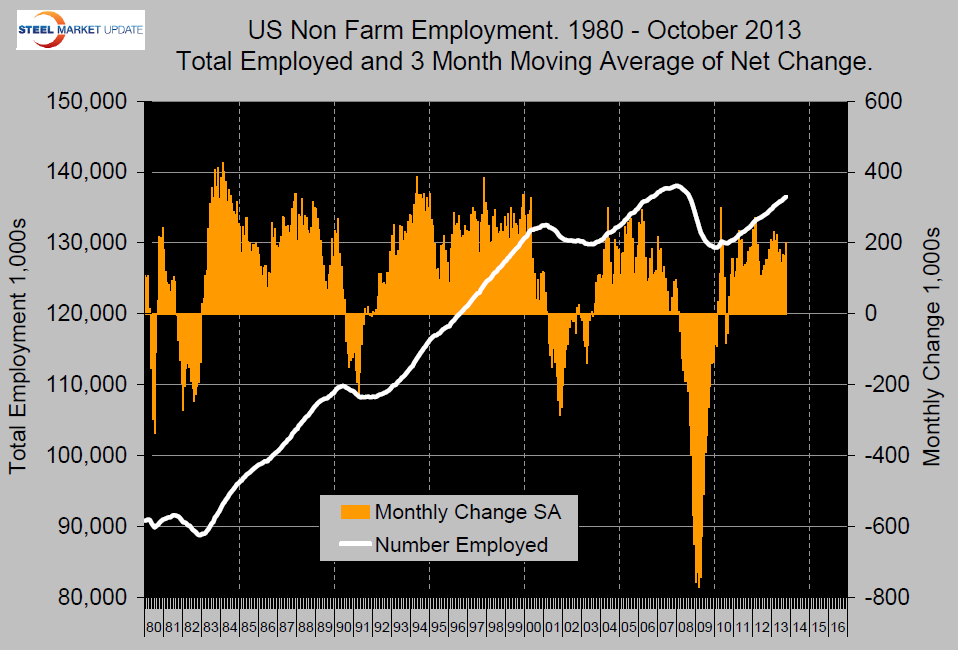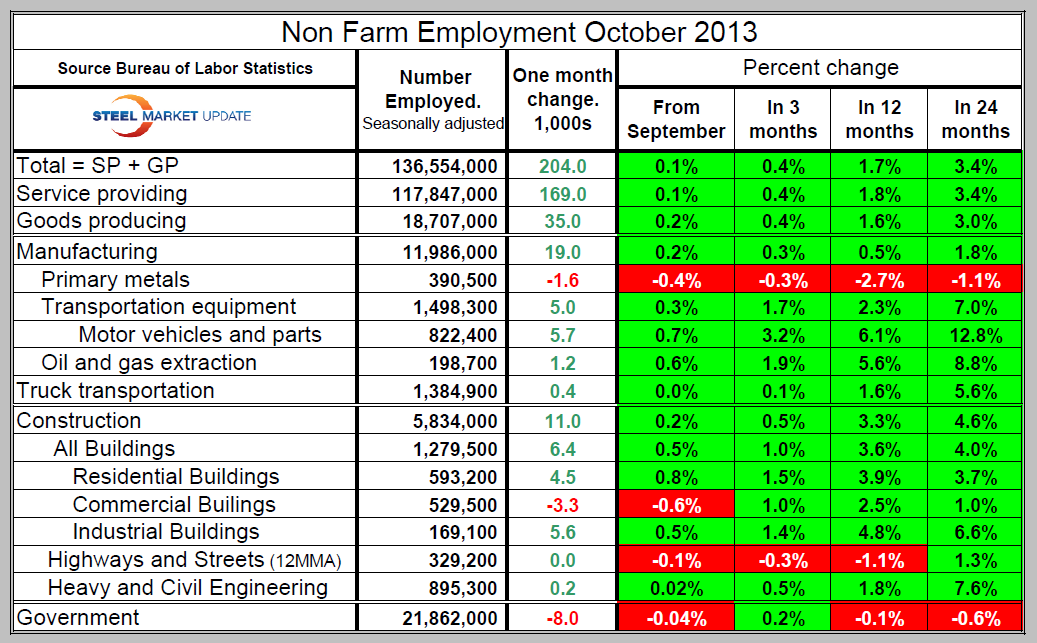Economy

Non-Farm Job Creation Surprises to the Upside in October
Written by Peter Wright
November 12, 2013
Net job creation in October was 204,000; August and September were revised up by 45,000 and 15,000 respectively. In October 169,000 jobs were created in services and 35,000 in goods producing industries.
The private sector added 212,000 jobs as government shed 8,000. Of the goods producing, 19,000 were in manufacturing and 11,000 in construction (Table 1).
 This was the best performance for manufacturing industries since February though the primary metals sector has lost 11,000 jobs in the last 12 months. Since February 2010 which was the employment low point following the recession, manufacturing has added 526,000 jobs and construction 312,000. Total employment is still on track to reach the pre-recession high by the third quarter of next year (Figure 1). It is evident from long term graphical analysis of total employment that the rate of recovery after a recession is slowing on each upswing.
This was the best performance for manufacturing industries since February though the primary metals sector has lost 11,000 jobs in the last 12 months. Since February 2010 which was the employment low point following the recession, manufacturing has added 526,000 jobs and construction 312,000. Total employment is still on track to reach the pre-recession high by the third quarter of next year (Figure 1). It is evident from long term graphical analysis of total employment that the rate of recovery after a recession is slowing on each upswing.
The official news release from the Bureau of Labor Statistics read as follows:
The Employment Situation – October 2013 – Establishment Survey Data
Total nonfarm payroll employment increased by 204,000 in October. Job growth averaged 190,000 per month over the prior 12 months. In October, job gains occurred in leisure and hospitality, retail trade, professional and technical services, manufacturing, and health care.
Federal government employment continued to trend down. There were no discernible impacts of the partial federal government shutdown on the estimates of employment, hours, and earnings from the establishment survey.
Leisure and hospitality employment rose by 53,000 in October. Within the industry, employment in food services and drinking places increased by 29,000, the same as its average monthly gain over the prior 12 months.
Employment in retail trade increased by 44,000 in October, compared with an average monthly gain of 31,000 over the prior 12 months. Job growth was widespread within the industry in October, with gains in food and beverage stores (+12,000), electronics and appliance stores (+10,000), sporting goods and hobby stores (+8,000), general merchandise stores (+8,000), and building material and garden supply stores (+7,000). Clothing and clothing accessories stores lost 13,000 jobs.
Professional and technical services employment rose in October (+21,000) and has grown by 213,000 over the past 12 months. Within the industry, employment in management and technical consulting services rose by 8,000 in October.
Manufacturing added 19,000 jobs in October, with job growth occurring in motor vehicles and parts (+6,000), wood products (+3,000), and furniture and related products (+3,000). On net, manufacturing employment has changed little since February 2013.
Health care employment increased over the month (+15,000). Job growth in health care has averaged 17,000 per month thus far this year, compared with an average monthly gain of 27,000 in 2012.
In October, employment showed little or no change elsewhere in the private sector, including mining and logging, construction, wholesale trade, transportation and warehousing, information, and financial activities.
Federal government employment declined by 12,000 in October. Over the past 12 months, federal government employment has decreased by 94,000. Federal employees on furlough during the partial government shutdown were still considered employed in the payroll survey because they worked or received pay for the pay period that included the 12th of the month.
The average workweek for all employees on private nonfarm payrolls was unchanged in October at 34.4 hours. The manufacturing workweek was 40.9 hours, the same as in September, and factory overtime was unchanged at 3.4 hours. The average workweek for production and nonsupervisory employees on private nonfarm payrolls edged down by 0.1 hour to 33.6 hours.
In October, average hourly earnings for all employees on private nonfarm payrolls edged up by 2 cents to $24.10. Over the year, average hourly earnings have risen by 52 cents, or 2.2 percent. In October, average hourly earnings of production and nonsupervisory employees edged up by 2 cents to $20.26.
The change in total nonfarm payroll employment for August was revised from +193,000 to +238,000, and the change for September was revised from +148,000 to +163,000. With these revisions, employment gains in August and September combined were 60,000 higher than previously reported.

Peter Wright
Read more from Peter WrightLatest in Economy

Architecture billings continue to slide in March
Architecture firms said billings continued to decline in March, according to the latest Architecture Billings Index (ABI) released by the American Institute of Architects (AIA) and Deltek.

Beige Book shows concerns about trade policy
Manufacturing was mixed, but two-thirds of districts said activity was little changed or had declined.

New York state manufacturing index drops again in April
Firms were pessimistic, with the future general business conditions index falling to its second lowest reading in the more than 20-year history of the survey

Construction adds 13,000 jobs in March
The construction sector added 13,000 jobs, seasonally adjusted, in March, but tariffs could undermine the industry.

Supply chains, end-users brace for impact from tariffs
Supply chains are working through what the tariffs mean for them

